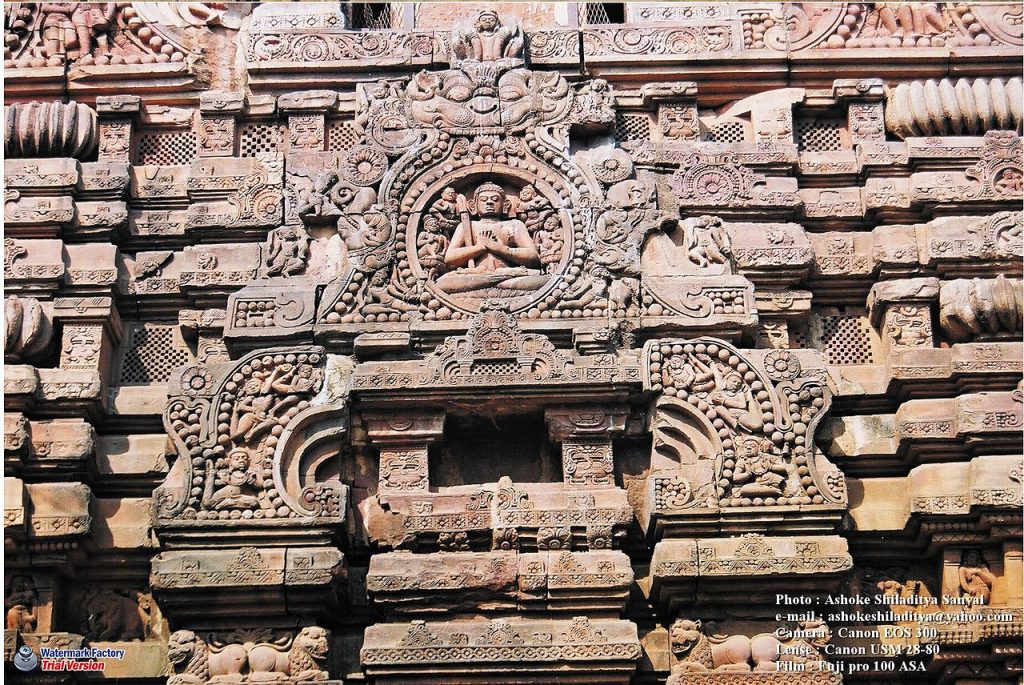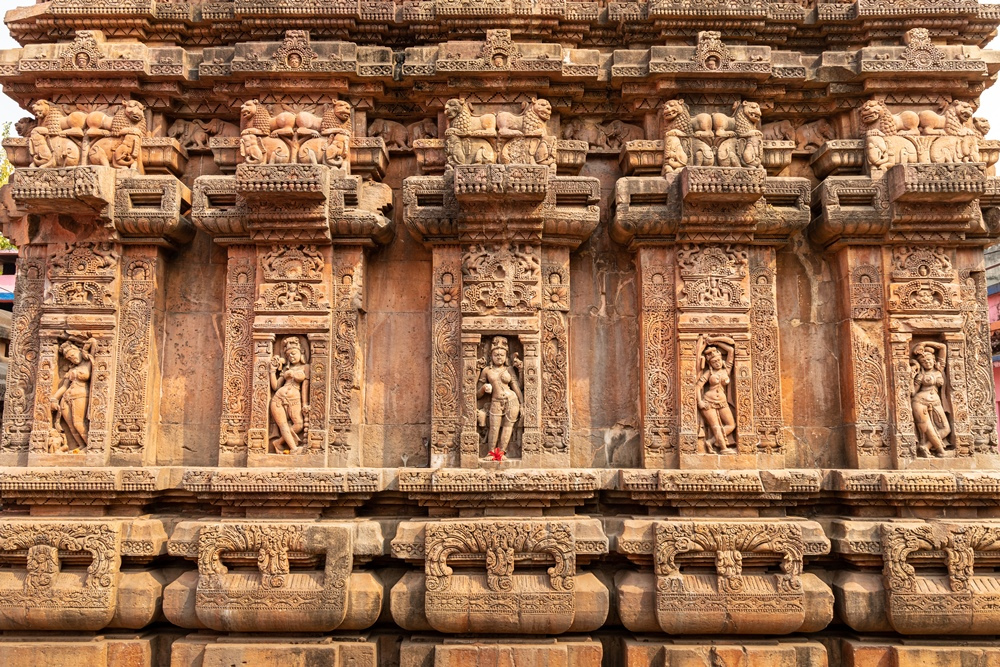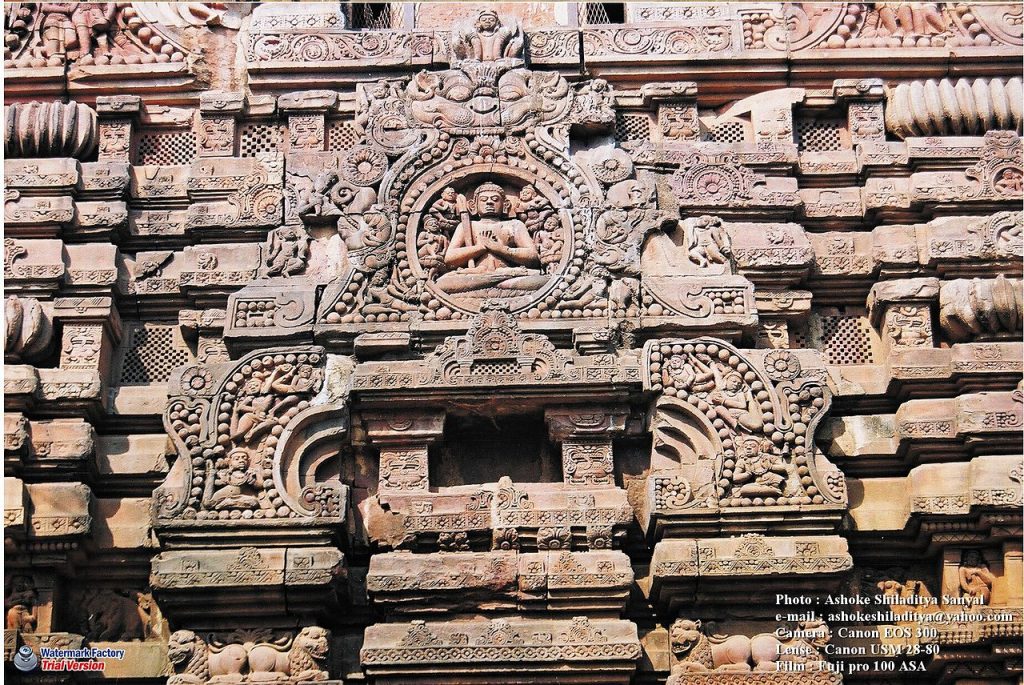Bhubaneswar known as the City of Temples is dotted all over with many beautiful temples which are reminiscent of a glorious past.
The Vaital Deula or Vaitala (meaning spirit or ghost) Deola (or Devalaya, a place where idols are worshiped) temple is situated in an nondescript corner of old Bubhaneshwar.
Architecture of Vaital Deula
Vaital Deula Temple was built in the 8th century and the region was a part of the Kalinga Empire.
A striking feature is the temple’s tantric associations, marked by strange carvings in the sanctum and the image enshrined in the central niche, eight armed Chamunda, locally known as Kapalini. Chamundi, the presiding deity, is portrayed as enthroned on a skeleton, wearing a crown of skulls and her bright red tongue protruding out.
She carries a serpent, spear, shield, knife, trident, thunderbolt, arrow and pierces the demon ‘s face. There are 15 niches around Chamundi ‘s image which are filled with mysterious figures. Also known as Tinimundia Deula is the temple because of the appearance of three spires at its peak. These three Spires reflect Goddess Chamunda ‘s three great powers Vaital Deula Temple.

It is of great architectural significance as the temple boasts its exquisite carvings and intricate designs and patterns. One can even find various inscriptions on the temple walls in the Odia script.
The temple is constructed from stone in the theme of Kalinga architecture. Inside the temple complex one can also find images of Lord Shiva, Lord Ganesha and Goddess Parvati Vaital Deula Temple.
The deula or tower of the temple is the most striking feature of the temple. The semi-cylindrical design of its roof bears a similarity with the South India temples of Dravidian gopuram. The deula plan is oblong, and the Vaital Deula Temple jagamohana is a rectangular structure & there is a small subsidiary shrine embedded in each corner.
Two chaitya windows dominate the front of the deula above the left of the jagamohana. Vaital Deula Temple The lower one, with Usha and Pratyusha firing arrows on either side, has a finely carved image of the sun god Surya noted for his facial expression. The upper chaitya-window is decorated with Nataraja with 10 arms.
You can read our another post on The Leaning Temple of Huma: A Unique Architectural Wonder

One look at the iconography on the outer walls of this temple, and it is clear, even to a layman that this is a Tantrik temple. There are Buddha-like god figures in the temple, with a mace in his right hand and a phallus pointing upward. In various Puranas he is the legendary Vaital Deula Temple Lakulisha mentioned. He and his four disciples-Kushika, Gargya, Kaurusha and Maitriya-are seen on scene.
Lakulisha was an Ajivika, a wandering monk who had retained the ancient knowledge of the occult. In the first century he restored shaivism in its original form, re-established the pre-Aryan culture and re-united under Pashupata, the numerous sects of shaivism that had existed for centuries in semi-secrecy.
In the Courtyard of Vaital Deula
His disciples believed Lakulisha was the last of Lord Shiva ‘s 28 manifestations. He is thought to have descended from a family of non-Aryan priests called Jangama, and rejected Vedism, Buddhism and Vaishnavism.
He re-instituted the practice of sacrifices including human sacrifices and restored the respect for Hatha Yoga and Tantrism and cosmological theories from the ancient Samkhya.
He is typically portrayed as a nude yogi in his left hand with a staff (lagud) and a citron (matu-linga) in his right hand with his erect penis (urdhva medhra) either standing or sitting in a Lotus pose.
Ardhanareshwar on the Walls of Vaital Deula
He was the last to embody the primordial tradition. The artistic principle in this practise was worshipped in the form of Pashupati-the breeder of all things, plants, people, spirits and gods.It is a part of the Mimansa school which is concerned with the peaceful co-existence of humans with the natural and supernatural worlds.
A Shri Yantra depicting Shiva and Shakti, from Tantric Shaivism or Trika school once prevalent in Kashmir, Maharashtra and Odisha.
According to sacred architecture, in Mimansa the temple represents a Mandala built in harmony with the archetypes and patterns of the universal and human. The meaning of numbers, the geometry of the Yantras, their orientation towards the sign of the zodiac, all play a vital role in the induction of states of being and in the interaction with gods and spirits
The Sampradaya Pashupati was an exquisite and spiritual Shaivism that embraced human propensities. It did not seek power or codification, but it aimed to find a balance in human nature. It did not deny the human body but used it as a tool for attaining the highest spiritual objective. It was a religion of nature, similar to the earth and much closer to the heavens.
Visit this temple and feel the tantric vibrations flow through you. A visit to Baitala Deula is considered a must when in Bhubaneswar owing to the legendary tales and powerful associations.
More: Wanted to download Odishashop.com visit here
How To Reach
By Air:
Bhubaneswar is well linked by air to other major Indian cities and hence you can take a direct flight to Bhubaneswar. Upon reaching the airport, you can take public transportation to Basistha Nagar, where the temple is located. The distance from the temple to the airport is 4 Km.
By Rail:
To get to the temple you can take a direct train to Bhubaneswar railway station and then from there, a bus or a taxi can be hailed to reach the temple.
By Route:
As a part of Odisha’s capital city Bhubaneswar, the Vaitala Deula Temple area has excellent road connectivity and is easily reachable.

